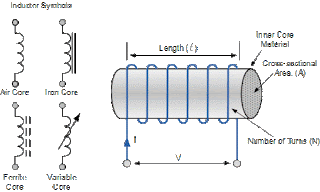Information about Electronics;
In this blog
I will be describe Inductor types and features.
Inductor;
An inductor,
also called a coil, choke, or reactor, is a passive two-terminal electrical
component that stores energy in a magnetic field when electric current flows
through it. An inductor typically consists of an insulated wire wound into a
coil around a core.
Inductor types based on core;
There are
different types of inductors. Depending on their material type they are
basically categorized as follows,
Air Core Inductor;
Ceramic core
inductors are referred as “Air core inductors”. Ceramic is the most commonly
used material for inductor cores. Ceramic has very low thermal co-efficient of
expansion, so even for a range of operating temperatures the stability of the
inductor’s inductance is high. Since ceramic has no magnetic properties, there
is no increase in the permeability value due to the core material.
Iron Core Inductor;
In
the areas where low space inductors are in need then these iron core inductors
are best option. These inductors have high power and
high inductance value but limited in high frequency capacity. These are
applicable in audio equipment’s. When compared with other core indictors these
have very limited applications.
Ferrite Core Inductor;
Ferrites are
mainly two types they are soft ferrites and hard ferrites. These are classified
according to the magnetic coercively.
Ferrite is also referred as
ferromagnetic material. They exhibit magnetic properties. They consist of mixed
metal oxide of iron and other elements to form crystalline structures . The
general composition of ferrites is XFe2O4. Where X represents transition
materials. Mostly easily magnetized material combinations are used such as
manganese and zinc (MnZn), nickel and zinc (niZn).
Soft Ferrite;
These
materials will have the ability to reverse their polarity of their
magnetization without any particular amount of energy needed to reverse the magnetic
polarity.
Hard Ferrite;
These are
also called as permanent magnets. These will keep the polarity of the
magnetization even after removing the magnetic field.
Ferrite core
inductor will help to improve the performance of the inductor by increasing the
permeability of the coil which leads to increase the value of the inductance.
The level of the permeability of the ferrite core used within the inductors
will depend on the ferrite material. This permeability level ranges from 20 to
15,000 according to the material of ferrite.
Iron Powder Inductor;
These are formed from very fine particles with
insulated particles of highly pure iron powder. This type of inductor contains
nearly 100% iron only. It gives us a solid looking core when this iron
power is
compressed under very high pressure and mixed with a binder such as epoxy or
phenolic. By this action iron powder forms like a magnetic solid structure
which consists of distributed air gap.
Laminated Core Inductor;
These core
materials are formed by arranging many number of laminations on top of each
other. These laminations may be made up of different materials and with
different thicknesses. So this construction has more flexibility. These
laminations are made up of steel with insulating material between them.
These are
arranged parallel to the field to avoid eddy current losses between the
laminations. These are used in low frequency detectors. They have high power
levels so, they are mostly used at power filtering devices for excitation
frequencies above several KHz.
Bobbin based inductor;
These are
wounded on cylindrical bobbin so these are named as bobbin based inductors.
These are mainly used for mounting on printed circuit boards.
It consist
of two types of leads they are axial lead and radial lead. Axial lead means
lead exits from both sides of the core for horizontal mounting on PC board.
Radial lead means lead exits from both sides of the core for vertical mounting
on PC board.
Multi-layer Ceramic Inductors;
The name
itself indicates that it consist of multi layers. Simply by adding additional
layers of coiled wire that is wound around the central core to the inductor
gives multi-layer inductor. Generally for more number of turns in a wire, the
inductance is also more.
Film Inductor;
These uses a
film of conductor on base material. Thus according to the requirement this film
is shaped for conductor application. Film inductors in thin size are suitable
for DC to DC converters that serve as power supplies in smart phones and mobile
devices.
Variable Inductor;
It is formed
by moving the magnetic core in and outside of the inductor windings. By this
magnetic core we can adjust the inductance value. When we consider a ferrite
core inductor, by moving its core inside and outside on which the coil is
wounded, variable ferrite core inductor can be formed.
Coupled Inductors
The two
conductors connected by electromagnetic induction are generally referred as
coupled inductors. We already seen that whenever the AC current is flowing in
one inductor produces voltage in second inductor gives us mutual inductance
phenomenon.
Molded inductors;
These inductors or molded by plastic or ceramic insulators. These are typically available in bar and cylindrical shapes with wide option of windings.





















































